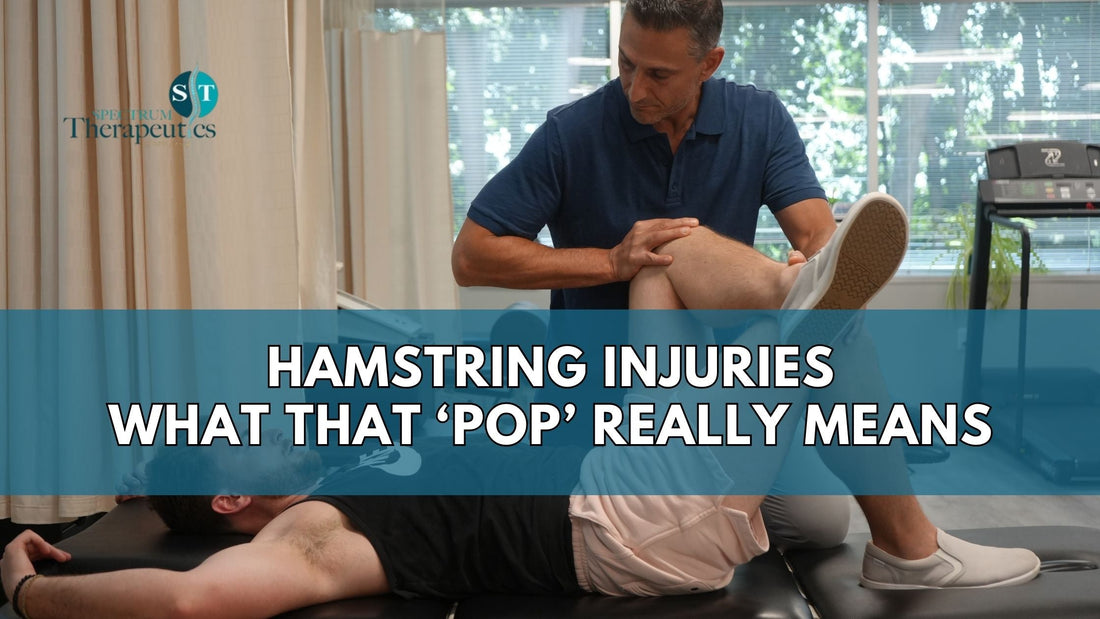
That Sickening "Pop" - What I Tell My Patients About Hamstring Injuries
Dr. Rob Letizia PT, DPTShare
I still remember the first time I heard that sound. I was working sideline coverage for a local high school track meet when this kid, probably ran a 10.8 hundred, pulled up mid-sprint grabbing his leg. The sound carried across the infield. That wet, snapping noise that every athlete dreads.
Twenty-three years later, I've probably seen over a thousand hamstring injuries. And you know what? The athletes who do well aren't necessarily the ones with the "minor" injuries. They're the ones who get the first 48 hours right.
Stop Being a Hero (Seriously)
Look, I get it. You're tough. You've played through worse. But that mentality? It's going to cost you weeks, maybe months. I had a college soccer player last year who "walked off" what turned out to be a Grade 2 tear. Kept practicing for three more days. What should have been a 4-week recovery turned into 14 weeks on the shelf.
The moment you feel that pop, and trust me, you'll know it when it happens, you stop. Period. I don't care if you're winning state championships or just trying to finish your morning jog. Get off that leg.
The Ice and Compression Game (But Not How You Think)
Everyone knows RICE, right? Rest, Ice, Compression, Elevation. But most people completely butcher the compression part. I can't tell you how many athletes come into my clinic with ace bandages wrapped so tight they're cutting off circulation, or so loose they might as well not exist.
Here's what actually works: Start your wrap about mid-thigh. Create that anchor point, this isn't rocket science, but it matters. Then work your way down, overlapping each pass by about half the width of the bandage. Here's the key part everyone misses: you want to pull with moderate tension as you cross over the injury, but only pull firmly every other wrap. Think "snug sweater," not "tourniquet."
Keep it on during the day, but for God's sake, take it off at night. Your leg needs to breathe.
When Crutches Aren't Just for "Serious" Injuries
This might be the most ignored advice I give: if you're limping, use crutches. I see athletes hobbling around like wounded warriors, thinking they're speeding up their recovery. You're not. You're just irritating inflamed tissue over and over again.
I had this marathon runner, smart guy, engineer, who refused crutches for what he called a "minor strain." Three weeks later he's still limping into my office wondering why he's not getting better. Sometimes the smartest thing you can do is admit you need help, even if it's just a simple mobility aid.
The Thing Nobody Talks About: Scar Tissue
After that first couple of weeks, when the sharp pain starts fading and you're thinking you're out of the woods, that's when most people drop the ball. They figure if it doesn't hurt, they're healed. Wrong.
This is when scar tissue starts forming. And if you don't address it, you're going to lose flexibility and power permanently. I'm not talking about some gentle massage at the spa. You need someone who knows how to work across the muscle fibers, what we call cross-fiber friction. It's not comfortable, but it's the difference between getting back to 100% and settling for 85%.
One of my former patients, a college track athlete, came back to see me five years after her hamstring injury. She'd skipped this phase of rehab because she "felt fine." She was still running, but never quite hit her old times. Don't be that person.
Stretching: Location Matters More Than You Think
This is where I see people waste a lot of time and effort. They Google "hamstring stretches" and do the same routine regardless of where their injury actually is.
If you tore something up high, near your glute, those straight-leg stretches you're doing? Probably not hitting the right spot. You need bent-knee stretches, bring that thigh in close to your chest.
If it's down low, near the knee, then yes, the classic straight-leg stretch with a towel or strap is your friend.
I know it seems obvious now that I've said it, but you'd be amazed how many people stretch the wrong area for months and wonder why they're not improving.
The Recovery Phase Everyone Skips
Here's where I lose most people. They get their mobility back, the pain's gone, and they want to start running again. But there's this crucial step that separates the athletes who stay healthy from the ones who end up back in my office six months later with the same injury.
Eccentric strengthening. Basically, training your muscle to control lengthening under load. It sounds fancy, but you can do it at home lying on your stomach. Bend your knee up, then slowly, and I mean slowly, let it drop while you resist the movement. Catch it before it falls completely, then reset.
It's not sexy. It's not Instagram-worthy. But it works. The research is clear on this: athletes who skip eccentric loading have reinjury rates through the roof.
Getting Back to Your Sport (The Right Way)
Most hamstrings heal in 4-6 weeks if you do everything right. Severe tears take longer, sometimes 3-4 months. But here's what I've learned: the timeline matters less than listening to your body.
I usually tell my athletes to start with easy jogging, then backward running (it's gentler on the hamstring), then some lateral movement, then plyometrics, and finally sprinting. But every day is different. Some days you'll feel great and want to skip ahead. Some days you'll need to dial it back.
That's normal. Healing isn't linear, and anyone who tells you otherwise is selling something.
Why Prevention Actually Matters
Look, I make my living treating injuries, but honestly? I'd rather see you never need to come in. Hamstring injuries love to come back, especially if you don't change what caused them in the first place.
Most hamstring injuries I see aren't really hamstring problems, they're hip problems, or core problems, or poor warm-up problems. Fix those, and you'll probably never see me for this particular issue again.
The Bottom Line
That pop in your hamstring doesn't have to end your season, or your running career, or whatever brings you joy. But it demands respect. Do the boring stuff, compression, proper stretching, eccentric strengthening, gradual return to activity.
Take it from someone who's seen this play out thousands of times: the athletes who get impatient early end up being patient for a lot longer.
Dr. Rob Letizia has been treating athletes at all levels for over two decades. When he's not in the clinic, he's usually trying (and failing) to keep up with his teenage daughter on the tennis court.



